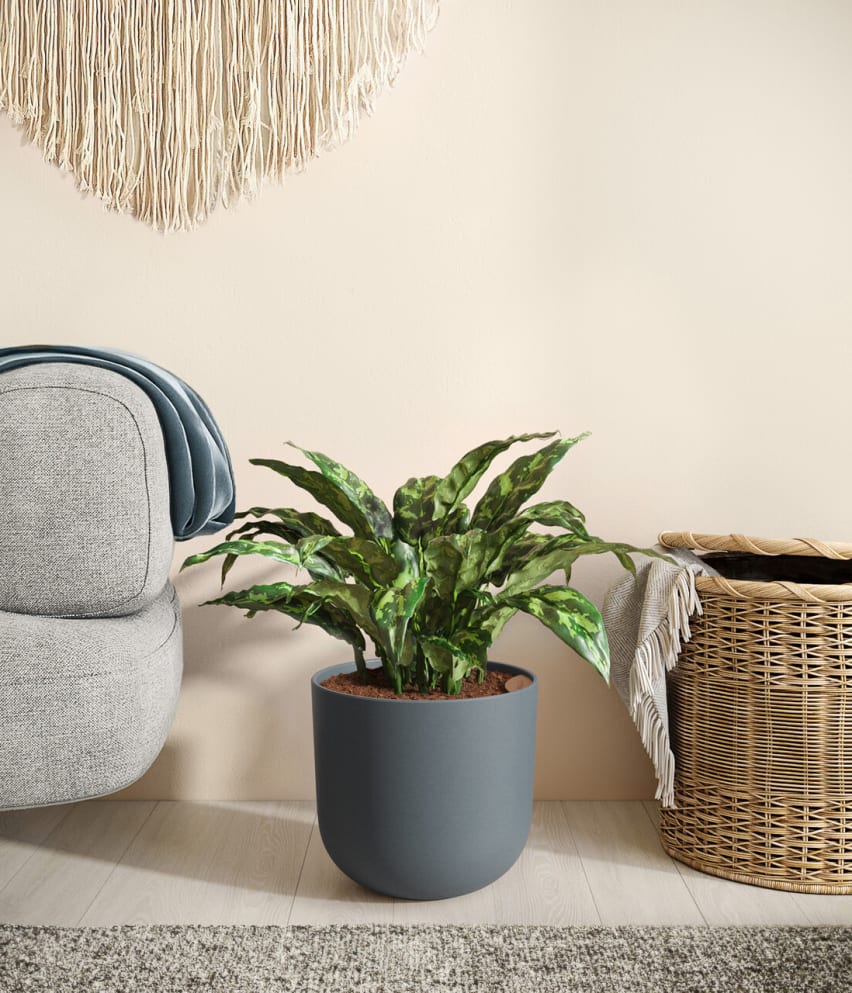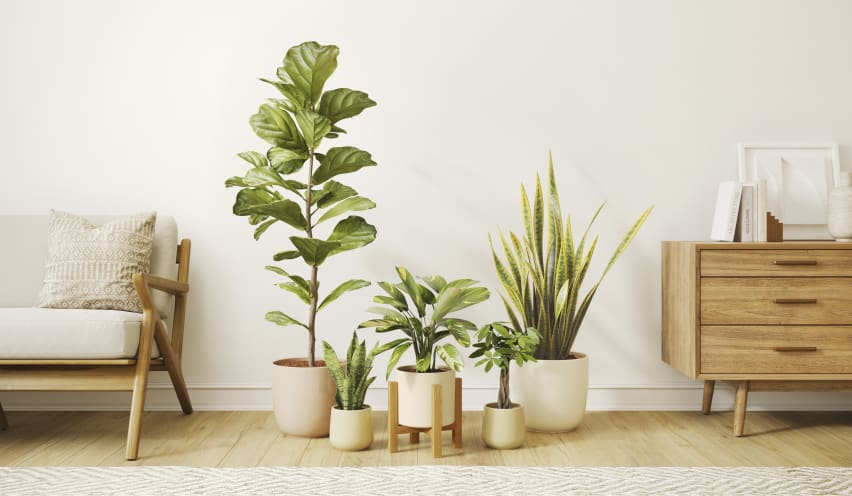About Aglaonema Siam
Native to the tropical and subtropical regions of Asia and New Guinea, Aglaonema Siam has been cultivated for centuries as a good luck charm. Known to live a long and healthy life, it is believed to bring wellbeing to the home and all its dwellers. Aglaonema Siam wears a vibrant, ruby-hued foliage that vivaciously warms up every space.
Other common names
- Chinese evergreen
- Poison Dart Plant
- Siam Aurora
- Aglaonema Firecracker
- Aglaonema commutatum
How Often Should I Water My Aglaonema Siam?
With easyplant, watering your Aglaonema Siam is simple. Make sure to check the easyplant reservoir once a month and fill it when empty, and you're all set!
Without an easyplant pot, you need to be careful not to overwater or underwater your Aglaonema Siam. The colorful plant thrives in moist soil, so try to allow it to dry out between waterings. Maintain this cadence throughout the year, lowering frequency a bit in the winter since it takes longer for the soil to dry.
Aglaonema Siam Light Needs
Aglaonema Siam grows best in a space with bright indirect light, where the sun rays are diffused, and can also adapt to spaces with medium to low light. Avoid placing it in spaces without natural light or with direct sunlight.
Bright indirect light helps keep the vibrant red and green colors on the plant’s leaves. While it can tolerate low light, in darker settings, you may notice that you lose some of its beautiful color. Be sure to avoid placing your plant in direct sunlight because the harsh rays can easily burn the delicate leaves. To get more details about how light affects plants, see our lighting guide. In the winter, you may want to move the Aglaonema Siam to a brighter location because the cooler temperatures and darker days can slow the plant’s growth.
Aglaonema Siam Plant Care
During your Aglaonema Siam’s first few days at home, one or two leaves might wilt, and should be cut. This is a normal part of adjustment and no cause for concern.
Once adjusted, Aglaonema Siam is very easy to care for, and will reward your love for it by quickly bouncing back from any mishap.
To help it grow optimally and evenly, occasionally dust the leaves and rotate the pot by a ¼ turn once a month
How Big Do Aglaonema Siam Plants Grow?
Aglaonema Siam grows slowly and steadily, reaching up to three feet tall and three feet wide. The more light it receives, the faster it will grow.
In low light, the plant’s growth tends to slow down, and it may lose some of its vibrant green and red leaf colors. Be sure to place your plant in an area with the right amount of light and space to grow to its full potential.
Temperature & Humidity
Knowing the right temperature and humidity for your houseplants is key to keeping them healthy. The Aglaonema Siam’s ideal temperature range is between 65°F to 76°F (18°C – 24°C). Be sure to keep the plant away from windows or vents that blast in cool temperatures – the Aglaonema Siam does best in a warm, humid, and bright environment like a greenhouse, so aim to mirror those conditions indoors. To enhance the humidity levels around your plant, consider grouping it with other plants or using a pebble tray, and position it in areas prone to higher humidity, such as a kitchen or bathroom.
Is Aglaonema Siam Toxic for Pets & Kids?
The fiery Aglaonema Siam contains insoluble calcium oxalates that can be toxic and harmful if ingested. The plant can cause skin irritation as well as oral irritation, swelling, and difficulty swallowing. So, be sure to keep it away from curious children and pets.
Troubleshooting Common Problems with Aglaonema Siam
The Aglaonema Siam is fairly easy to care for. If you water it properly and keep it out of direct sunlight, you shouldn’t have any problems. However, there are some signs that your beautiful plant could be under stress. If you notice that the lower leaves of your Aglaonema Siam begin turning brown, wait until they can be easily pulled off and then simply remove them to allow new growth on top. Additionally, if you notice spots, yellowing or browning of the leaves, or dry stems, it may be a sign of pests or disease. Make it a habit to regularly wipe off the foliage with any specks of dust and secretions, and try neem oil as a spray for both the upper and lower surface of the leaves.
If your leaves start to burn or curl, it may be a sign of too much direct sunlight so try to move the plant to a bright area that is not in direct sunlight. Additionally, Aglaonema Siam prefers drier to overly moist soil, so let the top layer of soil dry out before watering to prevent root rot.
Frequently Asked Questions about Aglaonema Siam Plant
How tall does an Aglaonema Siam grow?

The Aglaonema Siam grows fairly slowly. In optimal conditions, it can reach up to 3 feet tall and 3 feet wide.
Does Aglaonema Siam need sunlight?

The Aglaonema Siam thrives with indirect bright light. It can adapt to low light, but it will have slower growth. Direct morning sunlight is okay for this plant, but definitely avoid direct afternoon sunlight because it can burn the leaves.
Can Aglaonema Siam survive indoors?

The Aglaonema Siam will do best in the humid, warm, and bright environment, so it can thrive in doors with these types of conditions.



 Small Plants
Small Plants Medium Plants
Medium Plants Large Plants
Large Plants Huge Plants
Huge Plants Plants Collections
Plants Collections